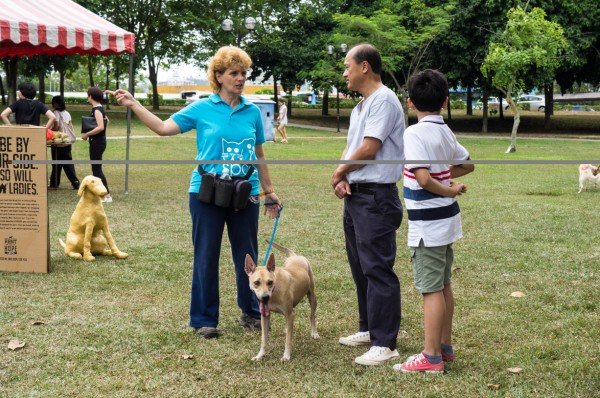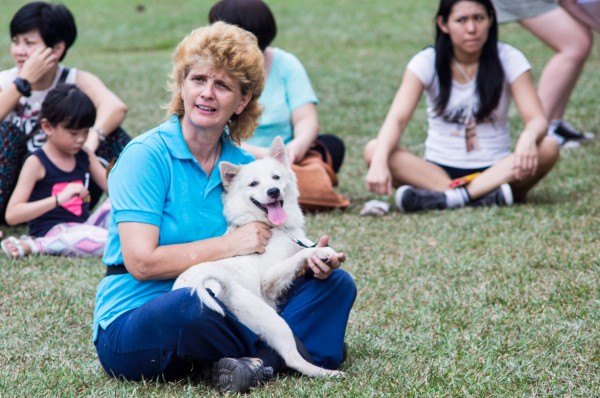Exciting Changes at SPCA Selangor!
| Tweet |
It�s been a long time since I�ve felt such a jolt of optimism in the realm of animal welfare. SPCA Selangor is in transition, and over the past six months, the staff members have thrown all their energy into this radical transformation. Part of the change is physical � the existing shelter structures will be razed to make way for the new SPCA Eco-Centre � but the more profound change is the new, holistic approach that SPCA is taking toward animal welfare in Malaysia.
It seems inevitable — whenever� big changes take place, the rumour mill grinds into high gear.� �I hear they�re going to euthanise all the animals who aren�t adopted by the time the construction starts!� �I�ve heard SPCA has gone broke, and that�s why they�re suddenly doing all this fund-raising��� �They won�t take my cat and week-old kittens � isn�t that what a shelter is for?!�
I spoke with Lorna Fisher, the SPCA Operations Change Manager, and I asked her what is really happening. In short, it is a very dramatic shift from the way SPCA Selangor has operated in the past. Some will applaud it, and others may not, but it is the most extensive, �big picture� effort that I�ve yet seen in Malaysia.� First and foremost, SPCA is not euthanising all its present shelter residents!� �Yes, the present shelter buildings will be demolished, so the animals need to vacate them.� The staff has been making a monumental effort over the past six months to find permanent or foster homes or places in existing animal sanctuaries for all of the animals.� When they began this drive, there were over 350 dogs in the shelter.� Now, in September, there are roughly 40, and the staff continues to go all out to place them before the construction begins.� The number of cats in the shelter has also dropped just as dramatically, thanks to the massive adoption efforts.� And yes, in preparation for this demolition and construction, SPCA has stopped accepting surrendered animals.� Instead, staff has asked people, �Can you work with us to find an adopter for this animal and to find alternate housing for it in the meantime, rather than simply dropping it off here?�
For the past 60 years, SPCA has expanded its facilities piecemeal, always in response to the immediate needs. As more animals were surrendered and discarded, makeshift buildings and shelters appeared on the property. �This,� Lorna says, �has to stop. We have been reactive for too long. It�s time to be pro-active.� For years, people have castigated SPCA for being a �kill shelter� � a facility that euthanises animals for which it cannot find adopters.� Lorna resists not only the �kill� aspect; she refuses to let the new facility be termed a �shelter�.� The new ARE (Adoption Rehabilitation Education) Eco-Centre will be a transition point for animals �� it will be neither a shelter, with its connotations of hopelessness and despair, nor a sanctuary, with its promise of lifelong care.
SPCA has been raising funds for the new Eco-Centre for the past five years, and has put on an extra push for the final contributions in the last few months (which has led to the inaccurate rumours that the organisation is in fiscal distress).� The new facility will have space for up to 100 dogs and 150 cats, “but my goal is to stay below 70% occupancy,” Lorna says, “and never to return to the days of saying, ‘Oh no — we’re full, so we’d better stack some cages on top of others, or build a new makeshift kennel.’”� The Eco-Centre will include space for dog-training and agility trials, and meeting and education rooms for humans.
When the new centre opens, the emphasis will be on viable — read adoptable — animals.� Animals which are too feral to tolerate human contact or those with significant health or behavioural problems will not be taken in.� Many may ask, but don’t all animals deserve care and rehabilitation? Indeed they do, but with limited funds, staff, and space, SPCA must focus on the animals which have the best chances of finding a good home and working diligently to ensure they find it.
�What we need,� Lorna says, �is a system of practical love for animals. What we are working toward is a no-kill Malaysia.�� The image she draws is of SPCA as a wheel with multiple spokes reaching out into the world of animal welfare, penetrating the many issues that contribute to animal suffering.� �Education,� she insists, �is fundamental.�� Here are some (but not all!) of the educational initiatives that are taking form at SPCA now.
Handler and Dog Training & Socialisation
“Dogs in shelter kennels tend to fall into two categories,” Lorna tells me. “Those with kennel depression, which people mistakenly interpret as unfriendliness, as the dog tends to cower in the back of the cage, and those with kennel stress.� The stressed dogs tend to bark, jump and reach out of the cage, which people wrongly read as excitement.� Unfortunately, the way most shelters operate, these dogs’ primary contact with humans consists of being grabbed — grabbed for vaccination, grabbed and taken to the clinic for treatment and neutering, grabbed and taken out for bathing, etc.� All in all, this picture is a far cry from what many people want to believe about an animal shelter — that it’s a safe, healthy, and tranquil sanctuary for animals.� Dogs suffering from either kennel stress or kennel depression are unlikely to attract potential adopters.
Lorna has begun a programme in which volunteers come in to socialise and do some preliminary training with the SPCA dogs.� In some cases, the socialisation has to start with encouraging a fearful dog to venture out from beneath a bench. Then it may progress to allowing the handler to rub a leash over its whole body, and eventually to being willing to exit the kennel on leash.� “First, will you come to me? Then, later, will you walk with me?� We’re talking baby steps here.� At some point, we’ll work our way up to Sit, or maybe even Down!”� A dog who is not too terrified to be handled and who will walk on leash is undeniably a more adoptable dog.
Properly socialised and well-trained dogs are also the key to achieving wider tolerance for dogs in Malaysia. We need more canine good citizens, and this means that dog-owners need to recognise the importance of training and setting boundaries for their pets. This is the second aspect of this programme — the education of the humans — and perhaps the more important.� If Malaysians see increasing numbers of polite, well-mannered dogs whose owners pick up after them, perhaps some of the “No Dogs” restrictions will relax, and that, too, will mean more dogs can be adopted.
Spay/Neuter Education and Outreach
SPCA has always promoted and advocated spay/neuter for pets, offering subsidised rates at its Klinik Kembiri in Setapak.� Plans to expand this effort include one or more Mission Help Vehicles, which will be multi-purpose support vehicles for adoption drives, fund raising events, community initiatives, mobile clinic and education outreach presentation.
Vets in Participation (VIP)
Hand in hand, paw in paw with the spay/neuter effort is a plan to collaborate with vets to promote the de-sexing of pets.� Lorna envisions the SPCA developing a panel of VIP vets who are on-board with the mission and who will offer discounts for the surgery. In return, SPCA will refer adopters and the public to these VIP partners.
Mixed-breeds are Cool!
We all know that the widespread preference for “branded” pets hampers adoption for thousands of fabulous animals who lack only a pedigree.� SPCA is launching a campaign to spread the word on all the advantages of adopting a mixed-breed pet.� How about fewer congenital health problems? These hardy, versatile dogs and cats have the best traits of all the breeds in their gene pools, so get with the programme, adopters!
Community Feeding Programmes
To tackle what sometimes feels like an intractable problem, Lorna refers to her own experience dealing with packs of stray dogs in the area where she lives.� “We started by approaching the neighbours and explaining what we wanted to do, and then the local restaurant owners.� We began collecting left-overs from the restaurants and feeding the strays to gain their trust. One by one, we spayed and neutered them, so they are no longer reproducing out of control. Now, we have, in effect, a rice-fed security force. The dogs don’t tear into rubbish bins, because they’re fed regularly on the restaurant left-overs. They don’t approach the neighbourhood residents, because they can’t be bothered, but if a stranger approaches, they bark.”� She adds, “If you call the council to remove all the strays in your area, you’ll have only temporary relief, because the minute the existing strays disappear, others will begin to move in.� In our area, our community dogs ensure that no other dogs encroach on their turf.”� �Working with residents to gain support for well-managed community feeding stations for both dogs and cats can have a tremendous impact on the way we deal with the stray animal population.
The construction of the SPCA�s� Eco-Centre is beginning now, and should be complete — with luck, fair weather and more finance — in 18 months.
| Tweet |




Facebook Comments